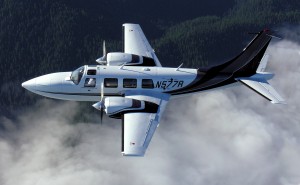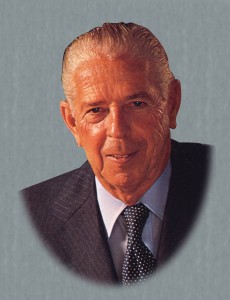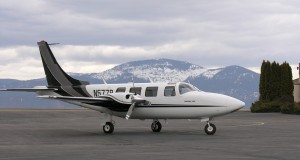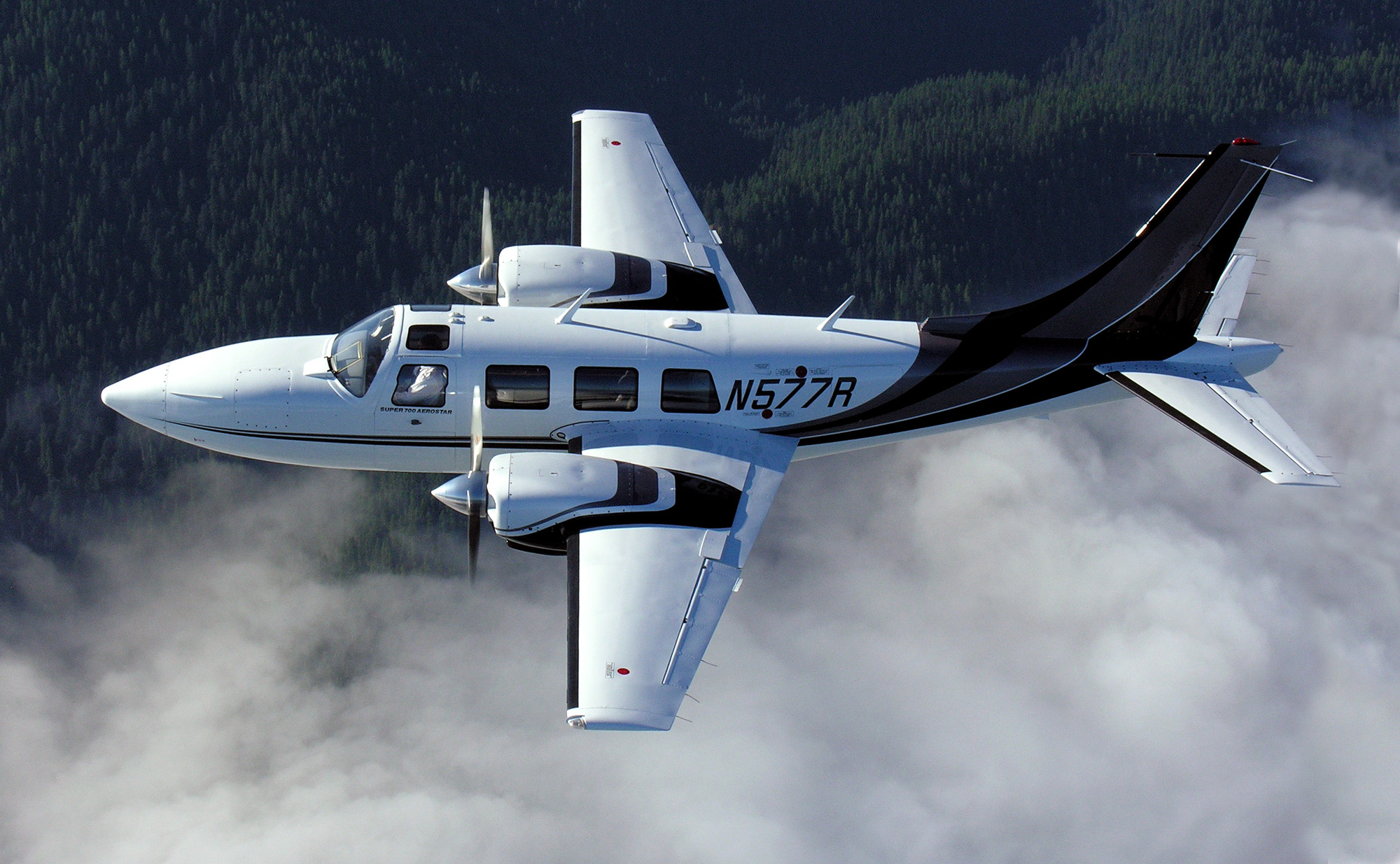
Built on the innovative Aerostar 600 and 601P airframe, the Aerostar 702P is the world’s fastest FAA certified reciprocating light twin.
By Clayton Moore
It may not have the name recognition of better-known airplanes like Beechcraft or Cessna, but among its enthusiasts, the Aerostar remains a longtime favorite. Today, the name survives through the hard work and passion of Aerostar Aircraft Corp., based in Hayden Lake, Idaho.
Maintaining, selling and upgrading the celebrated Aerostar is a labor of love for President Stephen R. Speer and Vice President James S. Christy. Both men started their careers in the original airplane company founded by the aircraft’s designer, Ted Smith. The company’s co-founders purchased the type certificate for the Aerostar from Piper in 1991.
The company’s latest triumph is the introduction of the Aerostar 702P, a new model announced last October. The new designation is given exclusively to upgraded versions of the 600 and 601P, previously manufactured models. Its many improvements make the Aerostar 702P a fine example of the utilization of new technology in a classic aircraft. According to Christy, the 702P is the world’s fastest FAA certified reciprocating light twin, with the highest payload of any fully equipped aircraft in that category.
“We’ve always wanted to improve this airplane,” Christy said.
Ted Smith’s masterpiece
Ted R. Smith contributed to some of the most fascinating airplanes of the 20th century. Working for Douglas Aircraft during WWII, Smith was the project engineer on the A-20 Havoc (the Air Force designation for the Douglas DB-7), a medium bomber and attack airplane considered essential to wartime efforts in Europe and North Africa. By the end of the war, he had overseen the production of nearly 9,000 A-20s.
After the war, Smith and several other veteran Douglas engineers started Aero Design and Engineering Co. in Norman, Okla. In 1946, they produced the first Aero Commander prototype. The company went on to produce the first pressurized light twin and the first light twin corporate turboprop. Before leaving the company in 1963, Smith was credited with the design of the Jet Commander, for Rockwell-Standard Corp.
Smith was one of the early advocates of business aviation, and the Aerostar remains a testament to his belief in the industry. With more than 40 years of design, certification and manufacturing experience to draw upon, Smith quietly developed an entire family of aircraft that ranged from a single-engine piston to a twin-engine turbofan. Enthralled with jet engines, he designed the Aerostar around reciprocating power but with the efficiencies of a jet aircraft in mind.
In 1969, he formed a company to produce the aircraft, originally working out of a hangar at Van Nuys Airport in California. He built aircraft through 1970, before selling the rights to the American Cement Company, which was seeking to diversify its interests. After getting more investors together, Smith reacquired his airplane from Butler Aviation, who had purchased the rights from American Cement. Smith restored production in 1973 in a facility in Santa Maria, Calif. It was about that time that Speer, a structural engineer, and Christy, a young airframe and power plant mechanic, became intrigued by the enigmatic airplane.

Ted R. Smith devoted his considerable talents to innovative projects ranging from the A-20 Havoc to the Aero Commander before turning his attentions to the Aerostar.
“As an A&P mechanic, you’re constantly working on different airplanes; it was quite a grind,” Christy recalled. “Every night, you’d take the maintenance manual home so you could put in a good day’s work and not have to learn on the job. I thought, ‘Wouldn’t it be great if you could become an expert on just one airplane?'”
Christy landed a job as a mechanic at Smith’s firm before moving up to be a technical representative, where Steve Speer first impressed him.
“I could see that Steve was a sharp guy,” Christy said. “He came into the company as chief of structures and was head and shoulders above a lot of the other technical personnel who were employed there. He came to work on the Aerostar 800 model, which was never produced. They were attempting to stretch the 600 frame and put eight-cylinder engines on it.”
The airplane was fascinating to the budding aviation professionals. According to Christy, Smith’s leadership particularly made the company successful.
“Ted was a very inspirational leader,” Christy remembered. “There was a lot of camaraderie and everybody felt good working there. He also had a lot of charisma. He told people what direction the company was going and kept everybody informed. I think he may have been a little difficult for some of the engineers, but overall, he was a very gifted leader. He was way ahead of his time.”
Beyond Smith’s leadership, the Aerostar production center was at the top of its game, producing an aircraft that was financially successful but was also ahead of its time in terms of technical capabilities. “It was a really neat company; it was like working at the Ferrari factory,” Christy said. “It was a small organization, just 400 people, turning out some of the best airplanes ever made. We had the world’s fastest reciprocating twin-engine airplane and it was selling really well.”
But the Aerostar entered a period of turmoil after Smith passed away in 1976. Piper bought the rights to the aircraft and continued producing it at its facilities in Vero Beach, Fla., until 1981, when financial strain threatened to put the company under. With pressures mounting, the transformation at Aerostar was palpable.
“It wasn’t the same,” Christy said. “The first thing Piper did was put up big banners that said, ‘Piper: More Airplane for the Dollar,’ and then immediately raised the price so you were actually getting the same airplane for more dollars. Aerostar just never fit in with the Piper way of doing things. I talked to a Piper engineer once who explained it to me this way: ‘The Aerostar is a BMW and we build Chevrolets here.'”
The change in the general aviation market was also bad news for Aerostar. At its peak, Aerostar had just 10 dealers in the country, selling a total of 100 airplanes a year. With Piper’s new distribution structure, airplanes were being delivered to Piper dealers who had never seen an Aerostar and weren’t qualified to demonstrate the plane to a potential customer. Sales took a nosedive.
Mods for sale

Stephen Speer, president of Aerostar Aircraft Corporation, has nearly 30 years of experience in FAA certification, aircraft development, structural design and analysis.
Speer and Christy left the company in the wake of the Piper acquisition, moving up to Spokane, Wash., where they formed Machen Inc. and a sister company, American Aviation Inc. Both companies were engaged in the production of aircraft modifications. Many of their improvements, some of which are still being produced and implemented today, were designed specifically for the Aerostar.
They even tossed around the wild idea of mounting jet engines on an Aerostar, only to find their predecessor had been there first. In 1985, the two men went to visit Dr. Sam B. Williams at Williams International, to inquire about potential engines for their modification project.
“Steve and I were in Dr. Williams’ office,” Christy remembered. “Williams said, ‘About 20 years ago, a young man was sitting in this office. His name was Ted Smith and he wanted to buy some fanjet engines for an airplane he was designing called the Aerostar.’ That was more than 40 years ago. He really designed the Aerostar for jet engines, and you can see that he designed it to operate at high speeds. You can’t have a lightly constructed wing or tail when you’re approaching 260 knots. It has higher flutter margins than a Cessna Citation. It’s just an unusually strong, robust design.”
Christy recognizes that less experienced pilots may not be fully sympathetic to some of the Aerostar’s nuances.
“It’s a fantastic design, but it has some idiosyncrasies,” Christy said. “When you open the cabin door, the pilot’s seat is in your way. You move it underneath the instrument panel and then everyone has room to get in through the door. That’s one of the things Piper dealers and magazine writers couldn’t understand. Also, if you’re a mechanic and you’ve never seen the aircraft before, you may pull the cowlings off and think it’s different from anything else on which you’ve worked.”
Despite those foibles, many pilots still believe the Aerostar has all the capabilities of a Beechcraft Baron but with greater capacity and handling characteristics.
“When people get in it, one of the first things they always say is that it’s bigger than they thought,” Christy said. “It looks small, aesthetically, but it’s bigger than a Baron on the inside.”
Christy, who directed the flight test certification program for Aerostar’s current development programs, also praises the aircraft’s flying characteristics.
“It’s the nicest handling airplane that I’ve ever flown and I’ve flown all the small twins,” Christy said. “I compare the control harmony to that of a Bonanza, but it’s better. It’s smoother in the controls, because there’s no backlash in the system. Instead of cables, it’s all push-pull tubes, like a Mooney, but it’s lighter in the controls than a Mooney. It’s really a joy to fly.”
The rebirth of the Aerostar
By the early 1990s, Machen was selling engine conversions, auxiliary fuel tanks and other performance improvements. But in 1991, when Christy called Aerostar owners, he’d often find that breaks in Piper’s supply chain were leading to problems. Piper’s financial troubles were causing numerous groundings in the Aerostar fleet, due to a lack of available parts.
If owners couldn’t fly their airplanes, they had no need for modifications, which crippled business for Speer and Christy. It was then that the men began to think bigger.
“We bought the rights somewhat in self-defense,” Christy admitted. “We had to do something.”

Jim Christy is a longtime advocate for the Aerostar family of aircraft. He manages market research, sales and marketing strategies for the company’s products.
By that time, entrepreneur Stuart Millar had bought Piper for $6 million, but the company was suffering massive financial losses. Most of the company’s 1,600 employees were furloughed in 1990, as rumors of bankruptcy circulated widely. Speer and Christy made some inquiries to one-time owner Lear Siegler Services, but eventually struck up a relationship with Millar, and found that he was an Aerostar owner and an advocate for the aircraft.
“Stuart was the one who really agreed to sell us the Aerostar,” Christy said. “He knew the mess Piper was in and that the Aerostar was probably the last airplane that Piper would care for. He liked it, and he liked us. He said, ‘I’ll sell it to you so we don’t let all these owners down.'”
They purchased the type certificate to the Aerostar as well as the tooling for the airplane, plus a number of spare parts from Piper’s inventory. They also immediately cut deals with parts vendors to get the flow of Aerostar parts moving again.
“We were able to get the Aerostar community flying again,” Christy said.
Their approach to the parts business diverges from more traditional approaches. While some aviation manufacturers would be happy to keep replacing poorly made or aging parts, the new Aerostar Aircraft Corporation has demonstrated its commitment to constant improvement of the airplane.
Piper sold a significant number of replacement parts per year. AAC has gone to the trouble of creating new parts, updated with the latest materials.
“These aging components were crackling, bubbling and blowing out,” Christy said. “We decided to make a new and improved system out of material that’s much stronger than stainless steel at the same temperature. Are we shooting ourselves in the foot? Yes, because once you give the owners new parts, they don’t have to purchase a replacement every few years. But we know if we make a good enough product, we can sell 50 or 60 systems the first year. That’s how we’ve done it.”
Of the 1,000 Aerostars that were produced, about 650 are still flying; the community of owners relies on Christy and Speer to keep their aircraft flying. The co-founders admit that challenges arise when getting into the business of being almost the sole support for an entire family of aircraft.
“We didn’t realize what a drain it can be when you have an airplane that’s out of production and someone calls in for something as simple as a landing gear door,” Christy explained. “If you can’t make it yourself, you have to have it hydro pressed and spot welded. You can’t just get one; you have to get 20. Hopefully, someone will need one down the road, but buying in that volume becomes an issue.”
Christy observed that the process gets even worse when it comes to actually making a significant change to the Aerostar that essentially involves the reengineering of parts.
“Let’s say you need a push-pull tube made of aluminum,” he said. “But the distributor has moved into doing military equipment and doesn’t want to make them any more. So, you go to a new vendor, but they can’t make it according to your drawing; however, they can make it with zinc. So now we have to have an engineer evaluate it, test it and then change all the drawings. The vendor issue is a big deal. I’m not going to say that we lose any money making spare parts, but I don’t think we make any either. It’s just something we do.”
With $4 million in annual sales, about a third of Aerostar’s business represents parts, while maintenance, improvements and aircraft sales make up the reminder. The company has the design and manufacturing rights to build brand new Aerostar aircraft, but that goal isn’t an immediate priority, according to the owners. Instead, they’re focused on restoring Aerostars to like-new condition, then updating them with numerous factory options developed during the past five years.
The 702P Aerostar

About 650 Aerostars are still flying, giving the new Aerostar Aircraft Corporation a lot of opportunities to apply the 702P improvements to existing aircraft.
These improvements have reached their peak in the new model 702P Aerostar. To create the aircraft, the company completely renovates a 600 or 601P model Aerostar. It’s then outfitted with 350-hp, turbocharged and intercooled Lycoming engines that give the aircraft a typical cruising speed of 261 knots. Other improvements include a vastly improved pressurization system that gives the airplane a higher certified ceiling and the addition of a KFC 225 autopilot system. Structural improvements further enhance the plane, giving it a 6,891 pound ramp weight with a resultant useful load of 2,200 pounds.
“The Aerostar 702P, with its impressive 270 knot true airspeed and sleek appearance, may have led some pilots to think it’s a hot airplane,” Speer said. “I know how these rumors get started, as the airplane even looks fast standing still. But it lands considerably cooler than other airplanes in its class. The stalling speed at normal landing weight is a mere 69 knots.”
He said the exceptionally low stalling speed is the result of good design and is substantially assisted by Fowler flaps.
“The slow flight characteristics are the best in class as a result of the slow flight system, including vortex generators that we developed more than 10 years ago,” he said. “Additionally, the ailerons are fully effective throughout the stall, which is unusual for this class of airplane. During the certification testing of the new 702P model, the Aerostar far exceeded the FAA criteria for stability, control, stall characteristics and recovery.”
Going to market
While the market for the aircraft is fairly specialized, Christy finds the Aerostar to be a terrific choice for pilots wanting to move up from other twin-engine airplanes.
“We know who our target market is, so we go directly to them,” Christy said. “I think it’s the best option for someone flying a Seneca or a Baron who wants a high-performance pressurized twin. There are some other options, like a Cessna 340, the pressurized Baron or possibly a Beechcraft Duke, but those are basically the same 1980 airplanes. Do they have the new Inconel exhaust system or the latest pressurization equipment? No, they don’t.”
The biggest challenge that Christy finds to putting a potential owner behind the stick of an Aerostar is the training factor.
“People need multi-engine experience in order to get insurance,” Christy said. “That’s a huge issue, and that’s why our target market for these airplanes is really people who already have twins. No one wants to go backwards in terms of speed and comfort to pay their dues in order to get into the airplane they really want. Lots of people who have the money don’t have that twin experience and are never going to go get it.”
Christy said that a “new” Aerostar would cost $1.5 million.
“A totally restored, practically brand-new Aerostar, under warranty, runs around $750,000,” he said. “That’s a phenomenal deal. The good news is that the Aerostars are mostly low-time airplanes, because they were mostly used as transportation for individuals and company owners.”
Speer and Christy moved the company in 2000 to a new facility at Coeur d’Alene Airport (COE), near Hayden Lake. Today, they have a 12,000-square-foot hangar and 18,000 square feet of manufacturing and office space, housing 28 employees. It’s been a learning curve, but the company continues to demonstrate its passion for Smith’s airplane.
“We’re always working on new things,” Christy said. “We’re basically selling factory options to Aerostar owners. We’re trying to sell a few airplanes and update others as well as selling a number of aircraft on consignment each year. You need a niche in aviation and we have a good one.”
For more information on Aerostar Aircraft Corporation, visit [http://www.aerostaraircraft.com].











